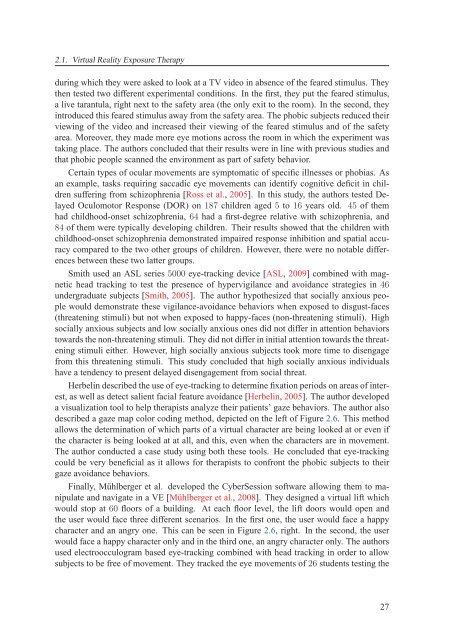Texte intégral / Full text (pdf, 20 MiB) - Infoscience - EPFL
Texte intégral / Full text (pdf, 20 MiB) - Infoscience - EPFL
Texte intégral / Full text (pdf, 20 MiB) - Infoscience - EPFL
Create successful ePaper yourself
Turn your PDF publications into a flip-book with our unique Google optimized e-Paper software.
2.1. Virtual Reality Exposure Therapy<br />
during which they were asked to look at a TV video in absence of the feared stimulus. They<br />
then tested two different experimental conditions. In the first, they put the feared stimulus,<br />
a live tarantula, right next to the safety area (the only exit to the room). In the second, they<br />
introduced this feared stimulus away from the safety area. The phobic subjects reduced their<br />
viewing of the video and increased their viewing of the feared stimulus and of the safety<br />
area. Moreover, they made more eye motions across the room in which the experiment was<br />
taking place. The authors concluded that their results were in line with previous studies and<br />
that phobic people scanned the environment as part of safety behavior.<br />
Certain types of ocular movements are symptomatic of specific illnesses or phobias. As<br />
an example, tasks requiring saccadic eye movements can identify cognitive deficit in children<br />
suffering from schizophrenia [Ross et al., <strong>20</strong>05]. In this study, the authors tested Delayed<br />
Oculomotor Response (DOR) on 187 children aged 5 to 16 years old. 45 of them<br />
had childhood-onset schizophrenia, 64 had a first-degree relative with schizophrenia, and<br />
84 of them were typically developing children. Their results showed that the children with<br />
childhood-onset schizophrenia demonstrated impaired response inhibition and spatial accuracy<br />
compared to the two other groups of children. However, there were no notable differences<br />
between these two latter groups.<br />
Smith used an ASL series 5000 eye-tracking device [ASL, <strong>20</strong>09] combined with magnetic<br />
head tracking to test the presence of hypervigilance and avoidance strategies in 46<br />
undergraduate subjects [Smith, <strong>20</strong>05]. The author hypothesized that socially anxious people<br />
would demonstrate these vigilance-avoidance behaviors when exposed to disgust-faces<br />
(threatening stimuli) but not when exposed to happy-faces (non-threatening stimuli). High<br />
socially anxious subjects and low socially anxious ones did not differ in attention behaviors<br />
towards the non-threatening stimuli. They did not differ in initial attention towards the threatening<br />
stimuli either. However, high socially anxious subjects took more time to disengage<br />
from this threatening stimuli. This study concluded that high socially anxious individuals<br />
have a tendency to present delayed disengagement from social threat.<br />
Herbelin described the use of eye-tracking to determine fixation periods on areas of interest,<br />
as well as detect salient facial feature avoidance [Herbelin, <strong>20</strong>05]. The author developed<br />
a visualization tool to help therapists analyze their patients’ gaze behaviors. The author also<br />
described a gaze map color coding method, depicted on the left of Figure 2.6. This method<br />
allows the determination of which parts of a virtual character are being looked at or even if<br />
the character is being looked at at all, and this, even when the characters are in movement.<br />
The author conducted a case study using both these tools. He concluded that eye-tracking<br />
could be very beneficial as it allows for therapists to confront the phobic subjects to their<br />
gaze avoidance behaviors.<br />
Finally, Mühlberger et al. developed the CyberSession software allowing them to manipulate<br />
and navigate in a VE [Mühlberger et al., <strong>20</strong>08]. They designed a virtual lift which<br />
would stop at 60 floors of a building. At each floor level, the lift doors would open and<br />
the user would face three different scenarios. In the first one, the user would face a happy<br />
character and an angry one. This can be seen in Figure 2.6, right. In the second, the user<br />
would face a happy character only and in the third one, an angry character only. The authors<br />
used electroocculogram based eye-tracking combined with head tracking in order to allow<br />
subjects to be free of movement. They tracked the eye movements of 26 students testing the<br />
27

















